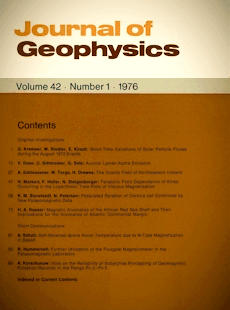Fault-plane solution of the earthquake in Northern Italy, 6 May 1976, and implications for the tectonics of the Eastern Alps
Article Sidebar

Vols. 1-18 (1924-1944), ISSN 0044-2801
Main Article Content
Abstract
The fault-plane solution of the North Italian earthquake of May 6, 1976, has been constructed from long-period records of 37 stations (mainly WWNSS stations), assuming a focus in the crust. It is essentially a thrust type solution, the compressional axis having an azimuth of about 160°, perpendicular to the strike direction of the Eastern Alps. One nodal plane is very well defined from first P-wave motions: it is steeply dipping approximately SSE with a dip angle of 77°. The second nodal plane has been determined from S-wave polarisations at stations in the United States and Japan: it dips roughly NW with a dip angle of about 16°. The dip direction of this nodal plane is less well defined. From the two possible interpretations of the fault-plane solution, either a shallow thrust of Italy under the Alps or a steep thrust of the Alps under Italy, only the first one is geologically plausible. The slip direction of the underthrusting block (or plate?) has an azimuth of 348° and a dip angle of 13°.
 ARK: https://n2t.net/ark:/88439/y072059
ARK: https://n2t.net/ark:/88439/y072059
Permalink: https://geophysicsjournal.com/article/280
Article Details
References
Bonjer, K.-P. (1976) Evidence for the rotation of the azimuth of the principal stress axis with depth in the crust of the Rhinegraben area. To be submitted to J. Geophys.
Gutdeutsch, R., Arie, K. (1976) Erdbcben im ostalpinen Raum ~ Beobachtungsmethoden unt tektonische Deutungsversuche. Publikation Nr. 210. Zentralanstalt for Meteorologie und Geodynamik in Wien.
Jeanrichard, F. (1975) Summary of geodetic studies of recent crustal movements in Switzerland. Tectonophysics 29, 289-292
Martinis, B. (1975) The Friulian and Julian Alps and Pre-Alps. In: Ogniben, L., Parotto, M., Praturlon, A. (Eds.) Structural model of Italy, Consiglio Nazionale delle Ricerche, Roma
McKenzie, D.P. (1972) Active tectonics of the Mediterranean region. Geophys. J. 30, 109-185
Nuttli, O., Whitmore, J.D. (1962) On the determination of the polarisation angle of the S wave. Bull. Seism. Soc. Am. 52, 95-107
Schaer, J.P., Reimer, G.M., Wagner, G.A. (1975) Actual and ancient uplift rate in the Gotthard region, Swiss Alps: a comparison between precise levelling and fission track apatite age. Tectonophysics 29, 293-300
Schneider, G., Schick, R., Berckhemer, H. (1966) Fault-plane solutions of earthquakes in Baden-Wurttemberg. J. Geophys. 32, 383-393
Senftl, E., Exner, C. (1973) Rezente Hebung der Hohen Tauern und geologische Interpretation. Verh. Geol. Bundesanstalt Jg. 1973, 2, 209-234











